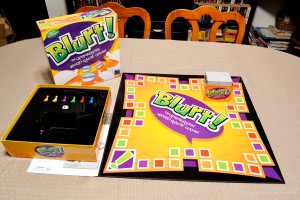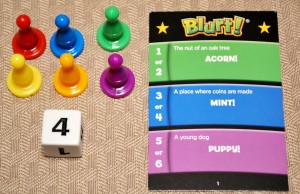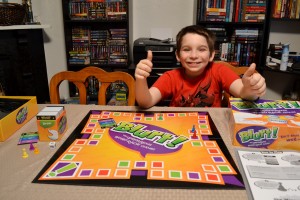I am a big fan of the game show “Jeopardy”, even if I’m lousy at it. Some of the answers are so vague or specific that I have a hard time coming up with the correct question. “Blurt!” is similar in play style in that a clue is read and players must guess the word, though the objective isn’t to accumulate the most money. Rather, you’ll be trying to move your game pawn around the board in order to complete a full lap before everyone else does. Before we sneak a peek at “Blurt!”, I’d like to thank Nancy Davies, the Vice President of Salmon Borre Group, for providing me with a free press copy.
*Editor’s Note: Up to four/six players can play individually, depending on the rule set chosen. A group of five/seven or more (respectively) will require folks to pair off into teams.
Components
Game Board – The board is lined with colored spaces along its perimeter. The game’s logo makes up the center of the board, where the dice can be rolled if desired.
Cards – There are a total of three hundred double-sided cards, with each side containing a total of three questions. The side marked with stars is kid-friendly while the other side will provide more of a challenge.
Game Pieces – There are a total of six pawns. Up to four are used in the normal game while up to six are used in the junior version rule set.
Setup & Gameplay
In the standard rule set, each player chooses a pawn (red, orange, purple, or green) and places them on the “!” space. The yellow and blue pawns are only used in the junior version rule set, which I’ll get to in a bit. Players can then decide which side of the cards they want to use throughout the whole game, though they can make it so that the current reader has the choice. Finally, each player rolls the die to see who goes first.
Players will take turns as “The Reader”, who draws a card, rolls the die, and reads the question on the card that corresponds with the die roll. A roll of a 1 or 2 prompts the first question, a roll of 3 or 4 prompts the second, and a roll of 5 or 6 prompts the third question. The answer is directly below the question. The other players or teams then blurt out answers at will and the first person or team to get it right moves their pawn the number listed on the die. Once that’s done, the role of “The Reader” moves clockwise around the table.
There are a few extra rules for players to consider while all of this is going on. If a player lands on another player’s pawn, a “one-on-one” challenge will occur. A neutral party draws a cards, reads a question of their choice, and the winner gets to stay on that spot while the loser has to go back from where the challenger came. When a player lands on a color of their own colored pawn, they can move to any space currently occupied by someone ahead of them and challenge them via the same process.
The first person or team to make it back to the “!” space (exact roll not needed) wins the game!
The above doesn’t cover all of the rules found in the manual, but should give you an idea as to how the game is played. For more information, please refer to the manual, linked below for your convenience.
http://www.educationalinsights.com/text/EI/downloads/guides/2917_webguide.pdf
The Review
The components were eye-catching and certainly on the colorful side. The vast number of cards available and the fact they are double-sided will help to prevent repeat questions from game to game, though if you play it enough, I suppose it is all but inevitable. Still, three-hundred cards with six questions each equals a lot of maths (okay, okay, eighteen hundred questions)…that’s a pretty impressive number compared to some other trivia games I’ve played in my day. The rules were easy to follow as well, making it easy to pick up and play.
The junior edition rule set was a nice touch. The developer could have stopped at the inclusion of the kid-friendly side of a card, but chose to go the extra mile by adding more pawns and a different rule set. Essentially, it’s the same idea as the core game in that players will be trying to lap their pawn around the board. However, the parent or teacher will always take on the role of the leader and read the questions aloud. Instead of blurting answers, each child writes down what they think the answer is and those who are correct, move forward. Correct answers with correct spelling move four spaces, while a correct answer with incorrect spelling moves three spaces. There are also no “challenges”, which is why more pawns can be used.
Likewise, some advanced rules exist to make the core game a bit more challenging. In the core game, players are allowed to blurt answers without penalty. In the “Hold That Thought” variant, each player or team gets one blurt and one blurt only. Those who are wrong are eliminated for the rest of that round. There’s also a “Name That Word” variant that functions like “Name That Tune”. When a six is rolled, players bid by claiming that they can solve the clue in X number of words. The lowest bid takes the guess and are rewarded or penalized accordingly, depending on their answer.
As detailed in the last two paragraphs, this game is very flexible. In theory, you could eliminate the colored square challenge rule from the core game and play with six players. If you have extra pawns or other pieces lying around, you could introduce even more players to the mix. I also like the fact that the reader can be given the choice to read either side of the card. Parents or teachers who are playing the game can read off the easy questions for the benefit of the kids while the kids can read off of either side. Creative folks will undoubtedly create their own variants to suit their play group.
All in all, “Blurt!” is an excellent educational party game for kids and adults alike. It’ll test your trivia knowledge a bit in addition to your vocabulary. Its flexible nature makes it suitable for players of almost any age. The junior edition serves as a better learning tool for younger kids in my opinion, as it gives each participant time to think about their answer rather than rush to call out any old word. Deciding whether or not to add “Blurt!” to your collection of family-friendly games is honestly a no-brainer…just do it.
Final Verdict: 9/10
—
You can learn more about and purchase “Blurt!” by visiting the following websites:
http://www.educationalinsights.com/product/blurt%21-reg-.do?sortby=ourPicks&sortby=&&from=Search
http://boardgamegeek.com/boardgame/1607/blurt
—




I kinda like this game.
I’ve played it about a dozen times and lost only once.
I liked it because I played with some people I feel have a low opinion of my IQ.
Beating the pants off them is a great feeling.
The surprise on their faces is worth the price of the game many times over.